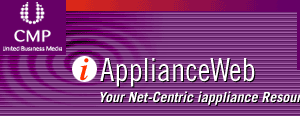



 |
 |
|
|
 |

|
||
|
|
|
|
|||

|
Sony DCM-M1 MD DISCAM: A Futuristic Video ApplianceBy Jeffrey Michalski
Before getting into the review of the Sony MD DISCAM, consider the job of an editor here at EDTN iApplianceWeb. On an average day two or three information appliances are announced or released to market. At major tradeshows dozens if not hundreds of devices are on display. Our job entails sifting through this steady stream of product releases, tracking down the actual working devices, and investigating and reporting on the technologies behind them.
I took the MD DISCAM on the road, put it through its paces, and found that it is a truly notable device that is ahead of its time with multiple features not found in any other camcorder on the market today. Unfortunately, it has one near-fatal flaw, which presents a significant limitation for those looking to take advantage of its innovation. MD DISCAM Features The MD DISCAM comes with a whole range of first-to-market features. It is one of the most innovative, groundbreaking consumer products in the camcorder market today. Some of these features, such as its optical disk storage, Ethernet interface, on-board Web server, and direct MPEG compression, will likely become standard on future generations of camcorders within next few years. The optical disk storage media is the first innovation worth examining. The MD DISCAM breaks with long tradition of using film or tape for recording live video. By moving to optical disk storage, the MD DISCAM opens up the possibility of flexible random access to all recorded information from the disk. The information for still pictures, audio, and video are stored in tracks. The tracks can be intermixed, edited, copied, moved, or erased in any order. This is a major improvement over the sequential access of tape. This technology also enables the introduction of sophisticated on-camera editing. The initiation of digital disk storage represents another big step into the digital age for video camcorders. Processing Video on the MD DISCAM Their solution is to do everything, including the compression, on the camera. Only the final video conversion to alternate media player formats such as Real or Microsoft Media may or may not be required. Using the Sony MD DISCAM methodology literally thousands of dollars in hardware, software not to mention time and effort, can be saved in the production of short clip streaming video.
Still, for professional video purist, compression on-camera prior to final editing translates into lost quality. The Sony natively stores the video on camera in MPEG2 format but exports the clips in Apple Quicktime .MOV format from the MD DISCAM. The video transferred in Apple Quicktime format has selectable frame rates and frame sizes. Unfortunately, Quicktime .MOV offers lousy compression, so video quality is lost in the process. The question is: how much quality is really lost? And what if a second compression or conversion of the multimedia format is required? These concerns certainly warrant further investigation, but are beyond the scope of this article. Tick-Tock, Downloading From the Sony MD DISCAM
To connect the MD MDISCAM to a PC, a crossover Ethernet cable can be used or the camcorder can be directly connected to a network using an Ethernet hub. This advanced networking connectivity is unique to the MD DISCAM in the camcorder market. Sony is expanding its support of native networking in its cameras. It is this feature that makes the device a video/camera appliance. Unfortunately, this is the one feature where Sony has fallen well short in terms performance. While the Web server is functional, it runs at very slow transfer rates of under 10K Bytes per second. This translates into hours of transfer time for even very short video clips, a flaw that definitely limits the usefulness of MD DISCAM. The irony is that this shortcoming is most likely attributed to their choice of running Java. Running Java without acceleration on embedded devices, such as the MD DISCAM, is well documented to significantly weaken the performance of the code execution. On this device the embedded Web server runs on top of Sun's Personal Java. Sony should have made more effort up-front investigating the limitations before committing to this technology path. In future generations perhaps Sony will select one of a number of native commercial embedded Web servers, which would perform more expeditiously. To see how the camcorder Web server is set up, click on the iApplianceWeb Sony MD DISCAM Appliance Spotlight. As one might expect, the TCP/IP address, gateway, and domain name server (DNS) must be configured by the user. It does not appear to support BOOTP of DHCP, and the server and perhaps even the operating system appear to be single threaded. This means no other features can be used on the camera when the Web server is running, a particularly unfortunate problem because with a little more effort Sony could have created a high quality live streaming Web-camera appliance. Further evidence of this is in Sony's recommendation that the Web server only be accessed by a single browser instance at a time. In fact, the camera and the embedded Web server were easily hung in normal operation. When hanging the server, it actually prevented even the most basic processes such as the on/off switch or menus from functioning properly. Ideally, the menus and user interface would run as one process and the network services as another process. In the future this would also allow for background tasking of video and audio filtering or effects. 
The MD DISCAM touchscreen allows you to designate the IP address for your connection. Sony technical support indicated that this was normal operation for DCM-M1. They were less informed about the capabilities for the capacity for Ethernet overall as a transport for video or audio. Did Sony make a mistake by supporting Ethernet and IP services on this device as compared to the more popular Digital Video over Firewire or USB? I don't thinks so. In the near future iApplianceWeb will post a technology review of these three emerging standards for wired communications and show that Ethernet is progressing at rapid rate toward gigabit speeds, and it offers reliable transport. Even at 100MB, it will be a viable alternative to either Firewire or USB. Of course, in the best of all worlds, all three should be supported, but this adds to the end product cost. Another problem with the video downloaded was that its audio track was decoupled and not download. To capture the audio sound track, a sound card and sound recorder software using the analog audio output were required. This has to do with Sony's use of their proprietary ATRAC encoding. Literally, on-camera the audio and video are stored separately. Because there is limited support for ATRAC in the commercial multimedia-editing tool, Sony chose not to provide ATTAC file download. This is too bad since ATRAC offers superior compression and sound quality to the more popular MP3. Sony MD DISCAM in Conclusion In the next generation, if Sony can fix the Web server, then build on the concept by improving the networking support, and then add capabilities to upload the latest compression algorithms, this very well may be future of digital camcorders. This month Sony is scheduled to begin shipment on the DVR-PC9 mini-DV HandyCam with built-in email capabilities. It's worth a look, but impatient downloaders beware. |
|
|||||||||||||||||||||||||||||||||||||||||||||||||||||||||||||||||||||||||

Terms and Conditions Privacy Statement |
|||||||||||||||||||||||||||||||||||||||||||||||||||||||||||||||||||||||||||